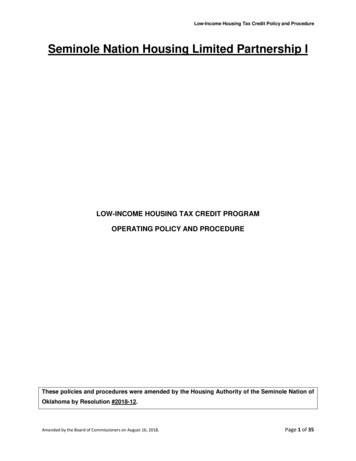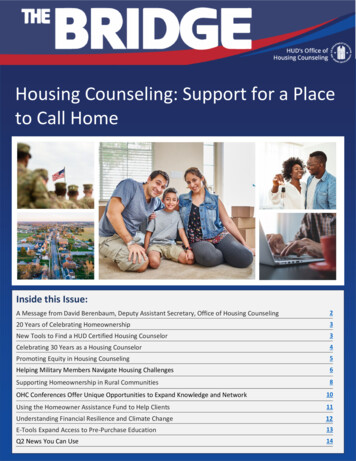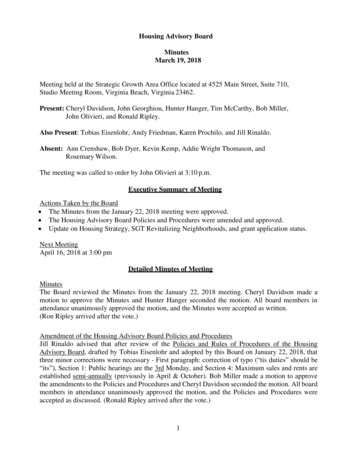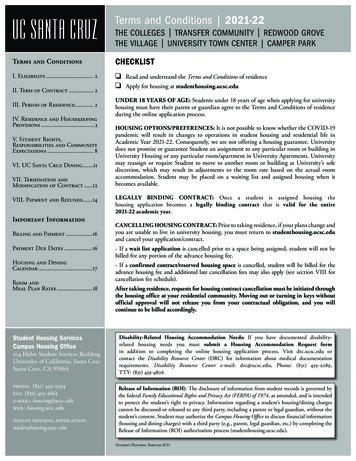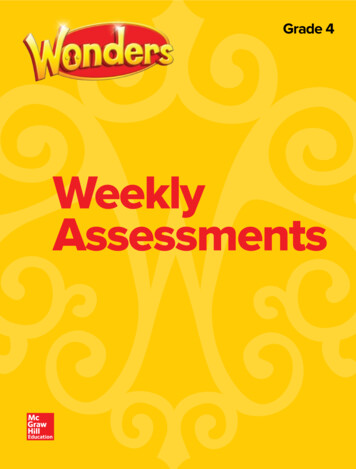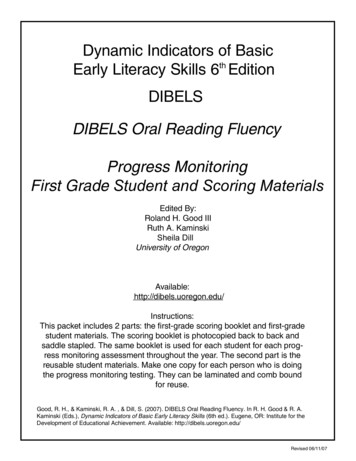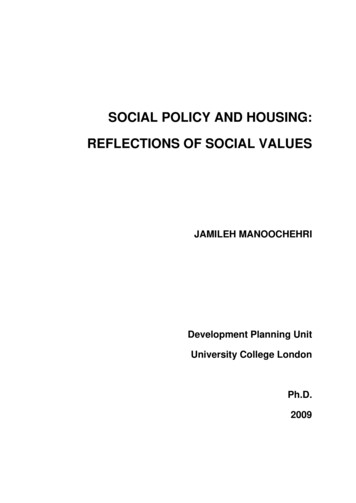Transcription
POLICY SPOTLIGHT ON HOUSINGThe looming eviction crisis is likelyto exacerbate racial and economicinequity in New York City andrequires bold policy actionSophie Collyer, Macire Aribot, Katherine Friedman, Chloe Sarnoff, Nicholos Wilkinson, Christopher WimerJanuary 2022
Introduction and key findingsOver the course of just a few weeks in March and April of 2020, as businesses andorganizations shut down to mitigate the spread of the coronavirus, hundreds of thousandsof families across New York City lost their main source of income. Nearly half of New Yorkerswho had been working and more than half of low-income New Yorkers lost income due to thepandemic. Before the pandemic, the city’s housing affordability crisis had already left 41%of renters rent burdened — defined as spending more than 30% of their income on rent— so for many families, missing one paycheck could mean there was no way to make theirnext rent payment. In turn, the likelihood of falling behind on rent rose by 50% for thosewho lost employment income because of the pandemic, leaving them at a much higher riskof eviction today than in 2019.The economic fallout driven by the pandemic has created a potential eviction crisis. But government policies,like eviction moratoria, rental assistance programs, and other pandemic-related relief policies have so farprevented a swell in eviction filings: weekly eviction filings in New York City for 2020 and 2021 were wellbelow historical averages.1 But these policies and programs have either exhausted their funding, alreadyexpired, or will soon, while more than 1-in-4 renters in New York City continue to report having missed a rentpayment or being in arrears. For example, New York State’s 2.4 billion Emergency Rental Assistance Program(ERAP) helped tenants who owe back rent cover up to a year’s worth of missed payments, but the funds werelargely paid out as of December 2021, while only covering a third of the applications received.2 And New YorkState’s eviction moratorium, the policy that has likely played the most powerful role in preventing evictions,is scheduled to end on January 15th, 2022. (See Appendix A for additional information regarding thesepolicies.)As New York State’s eviction moratorium ends, New York City will be at risk of a massive increase in evictionsand homelessness. To prevent this crisis, policymakers must implement solutions that address both shortterm needs related to pandemic arrears and longer-term issues of housing affordability in New York City. Thisreport uses Poverty Tracker data to examine possible consequences of ending the state’s eviction moratorium,the factors driving the potential eviction crisis (including those that pre-date the pandemic), and policies thatcould help avert an eviction crisis and promote greater housing stability in the long run. Eviction Lab (2021).New York State Office of Temporary and Disability Assistance (2021).12JANUARY 2022 P OL I C Y S P OT L I GH T ON H OUSING2
The findings show that:The pandemic has worsened housing hardship in New York City, particularly forthose who bore the brunt of its economic consequences. These New Yorkersface the greatest increased risk of eviction when the moratorium expires.28%41%50%RISENew Yorkers who lost employment income because of thepandemic are significantly more likely to be at risk of eviction nowthan they were in 2019. Their likelihood of falling behind on rentrose from 28% to 41%, a rise of nearly 50% in relative terms.3Lifting the eviction moratorium will also likely have an outsized effect on low-income New Yorkers andon Black and Latino New Yorkers, deepening economic and racial segregation in the city.While data from the Poverty Tracker shows how the pandemic has worsened housing hardship,New York’s housing affordability crisis pre-dated the pandemic and has long left New Yorkersvulnerable to missing rent payments and to facing evictions.30%INCOMERENTThe U.S. Department of Housing and UrbanDevelopment (HUD) identifies families whopay more than 30% of their gross incomeon rent as rent burdened, noting that rentburdened families “may have difficultyaffording necessities such as food, clothing,transportation and medical care.”4Pre-pandemic, the average low-income New Yorker5in a market-rate rental unit spent more than half theirincome on rent.6 Their average annual gross income7 was 31,900 and annual rent amounted to 16,188 ( 1,349per month). High rates of rent burden left New Yorkersstruggling to make monthly rent payments and vulnerableto eviction. Nearly 1-in-3 rent burdened New Yorkers fellbehind on rent at least once in an average year.Before the pandemic,roughly 41% of NewYorkers in rentalhousing and 67% ofrenters living in povertywere rent burdened.RENT 31,900 16,188INCOMERENTRENTBlack and Latino New Yorkers were also disproportionately affected by the housing affordability crisisand faced above average rates of rent burden before the pandemic. See Appendix B for information regarding how we identify and discuss the race and ethnicity of the Poverty Tracker participants.U.S. Department of Housing and Urban Development.5Defined as New Yorkers living below 200% of the poverty threshold, as determined by the Supplemental Poverty Measure.6 We identify New Yorkers in market-rate rental units as those who are not receiving rent subsidies or vouchers and are not living in apartments that arerent stabilized.7Note this is restricted to pre-tax cash income.34JANUARY 2022 P OL I C Y S P OT L I GH T ON H OUSING3
Policy pathway to stave off eviction crisisExtending the eviction moratorium would forestall an eviction crisis in the short-run, but itwould not address long-standing issues that force so many households into housing hardshipand instability. To protect New Yorkers and build towards a more equitable and secure futurefor residents, New York City policymakers could implement and expand a range of policies thatwill help New Yorkers afford housing. This includes expanding rental assistance to more lowincome New Yorkers who are at risk of eviction and homelessness. RENTAL ASSISTANCE2.4 MILLIONPEOPLE IN THE UNITED STATESOUT OF POVERTYRental assistance vouchers, such as federal Housing Choice Vouchers, keep roughly 2.4 millionpeople in the United States out of poverty, reduce housing instability, and prevent evictions.But access to vouchers is limited.CITYPOVERTYRATE Given the power of rental assistancevouchers, Robin Hood, the CenturyFoundation, and Next100 proposed apolicy reform that would expand accessto the city’s Family Homelessnessand Eviction Prevention Supplementprogram (CityFHEPS), a rentalassistance voucher for New Yorkersexperiencing homelessness.23%Analysis in this report shows that before the expansionof CityFHEPS could cut the city poverty rate by up to23%, and by up to 39% among recipients, reducinghousing instability and the number of evictions in turn.About The Poverty TrackerLaunched in 2012, the Poverty Tracker surveys a representative sample of New Yorkers every threemonths, providing critical information on the dynamics of poverty and other forms of disadvantagein the city. In addition to measures on poverty and disadvantage, the Poverty Tracker collects awealth of information on other topics such as employment, assets and debts, health, and housing.JANUARY 2022 P OL I C Y S P OT L I GH T ON H OUSING4
What the Poverty Tracker data tells us aboutthe looming eviction crisisThe pandemic has worsened housing hardship in New York City, particularly for those whobore the brunt of its economic consequences. These New Yorkers will likely be those mostimpacted by the lifting of the eviction moratorium.Since 2019, the share of renters in the Poverty Tracker sample who fell behind on rent at least once in a yearlong period rose from 22% to 26%, pointing to the increase in New Yorkers’ inability to make rent (Figure 1).8Figure 1Share of New Yorkers in the Poverty Tracker sample who fell behind on rent in atleast one month of the yearNEW YORKERS IN FAMILES WHO DID NOT LOSE EMPLOYMENT INCOME BECAUSE OF THE PANDEMICNEW YORKERS IN FAMILES WHO LOST EPLOYMENT INCOME BECAUSE OF THE PANDEMICALL NEW YORKERS IN THE POVERY %0%20162017201820192020/2021Source: Poverty Tracker annual survey data, second cohort.Note: The most recent Poverty Tracker data on missed rent payments was collected in the summer and fall of 2021 in reference to the 12-months prior. Thus,the most recent data point refers to missed rent payments in late 2020 through the fall of 2021. Results calculated using a regression analysis controlling forage, gender, marital status, immigration status, race and ethnicity, and presence of children in household.8 he Poverty Tracker survey item that asks about respondents’ ability to pay rent reads, “In the past 12 months, did you not pay the full amount ofTrent or mortgage because there wasn’t enough money?”JANUARY 2022 P OL I C Y S P OT L I GH T ON H OUSING5
But looking at the average share of renters who fell behind on rent since the pandemic hides the fact thatthere have been two distinct experiences since its onset. Some New Yorkers have not experienced any lossesof employment income, have seen their expenses fall, and may have even been able to save some money.9Others, however, lost employment income and faced financial precarity while navigating the UnemploymentInsurance system and an uncertain future. And these two experiences result in a diverging trend: When askedin the summer and fall of 2021, roughly 41% of renters who experienced pandemic-related income lossesreported falling behind on rent at least once in the previous 12 months versus 15% of renters who had notfaced these losses.Data collected on these same New Yorkers in prior years shows those who lost employment income because ofthe pandemic are significantly more likely to be at risk of eviction now than they were in 2019. Their likelihoodof falling behind on rent rose from 28% to 41%, a rise of nearly 50% in relative terms, while there was littlechange for those who didn’t lose employment income (17% to 15%). Taken together, these results show thatNew Yorkers who have already been dealt financial blows related to the pandemic will be those who face ahigher risk of eviction once the state-level moratorium expires.Lifting the eviction moratorium will also likely have an outsized effect on low-income New Yorkers and onBlack and Latino New Yorkers, deepening economic and racial segregation in the city. The results in Figure 1reinforce the point that New Yorkers who were already in precarious financial positions bore the brunt of theeconomic consequences of the pandemic. New Yorkers who eventually lost employment income because ofthe pandemic were already substantially more likely than those in families without reported income losses tohave fallen behind on rent before 2020 (28% vs. 17%). Poverty Tracker data shows that income losses werealso significantly more common among those who were low-income or in poverty before the pandemic thanmiddle- and higher-income workers (55% vs. 36%; Figure 2).Figure 2Prevalence of pandemic-related income losses by income level55%LOW-INCOME WORKERS AND WORKERS IN POVERTY36%MIDDLE-AND HIGH-INCOME WORKERS0%10%20%30%40%50%60%Source: Poverty Tracker annual survey data, second cohort.Note: Low-income workers and workers in poverty defined as workers living below 200% of the poverty threshold before the pandemic, and middle and highincome workers, those above 200% of the poverty threshold. Poverty thresholds are defined using the Supplemental Poverty Measure.9Gould and Kandra (2021).JANUARY 2022 P OL I C Y S P OT L I GH T ON H OUSING6
Earlier Poverty Tracker analyses find that Black and Latino New Yorkers were more likely than white NewYorkers to lose employment income because of the pandemic, and this was also true at the national level.10When interviewed in the summer and fall of 2021, 1-in-4 Black or Latino New Yorkers11 in our representativesample reported being unable to make a rent payment or owing back rent to their landlord, versus 1-in-10 ofwhite New Yorkers.Taken together, these results suggest that when the eviction moratorium ends, New Yorkers who lost incomebecause of the pandemic, low-income New Yorkers, and Black and Latino New Yorkers will be at greater riskof being forced out of their homes than higher-income New Yorkers and white New Yorkers. At the individuallevel, this means that these groups will be more likely to endure the secondary effects of evictions – whichhave been found to negatively impact physical and mental health, to increase one’s likelihood of losingemployment, and to push some families into homelessness.12 For those with children, these evictions couldalso affect their children’s health and educational development.13For the city, failing to address the eviction crisis, which will disproportionately affect lower-income peopleand Black and Latino New Yorkers, would further entrench economic and racial segregation, as families whoare evicted are often pushed into higher poverty areas.14 For reasons related to discrimination and policiesthat reinforce and reproduce structural racism, the end of the eviction moratorium will likely compound thehardships already disproportionately borne by low-income New Yorkers and Black and Latino New Yorkers.Informal evictions and forced moves have persistedthroughout the pandemicWhile New Yorkers have been largely protected from formal evictions during the pandemic, anecdotalevidence suggests informal evictions and other forms of forced displacement — such as moving becauseyou are being harassed or told to leave by your landlord or the leaseholder — are becoming morecommon.15 And this trend is also showing up in the Poverty Tracker data. These forms of forced movescarry the same consequences of pushing families into higher-poverty neighborhoods and concentratingpoverty in the city. And while not typically classified as a forced move,16 the latest Poverty Trackerdata also suggest that more New Yorkers are moving because of maintenance issues and landlords nottending to repairs, a finding also in line with anecdotal evidence.17 These trends underscore the need foradditional protections for tenants and for additional funding to support housing organizing groups thateducate the public about their rights as tenants.Saenz and Sparks (2020).See Appendix B for information regarding how we identify and discuss the race and ethnicity of the Poverty Tracker participants.12Preston & Reina (2021).13Shelly (2020).14Desmond & Shollenberger (2015). Evidence from the Poverty Tracker shows how this trend is also true in New York City; see Collyer & Bushman-Copp (2018).15Kinniburgh (2021); Stringer (2021).16 See Collyer & Bushman-Copp (2019) for definitions of forced, responsive, and voluntary moves based on Desmond & Shollenberger (2015).17Zaveri (2021).1011JANUARY 2022 P OL I C Y S P OT L I GH T ON H OUSING7
The pandemic has exacerbated housing hardship in New York City, but millions of NewYorkers struggled to afford rent long before 2020.The pandemic has had a demonstrable impact on housing hardship18 in the city, but New Yorkers have beenstruggling with the city’s high housing costs for years. The U.S. Department of Housing and Urban Development(HUD) identifies families who pay more than 30% of their gross income on rent as rent burdened,19 and beforethe pandemic, roughly 41% of New Yorkers in rental housing (approximately 2 million) could be classified asrent burdened (Figure 3). Rent burden was even more common among New Yorkers in poverty. Two-in-three(67%) New Yorkers living in poverty (roughly 1 million individuals) were rent burdened in the years leading upto the pandemic.Figure 3Prevalence of rent burden in New York City, five-year average (2015-2019)ALL RENTERS2,100,000 NEW YORKERSRENTERS IN POVERTY1,080,000 NEW ce: Poverty Tracker annual survey data, second and third cohorts.The high cost of housing left rent-burdened New Yorkers substantially more likely to fall back on rent, puttingthem at an increased risk of eviction. On average, in the five years prior to the pandemic, 23% of New Yorkersmissed a rent payment in a year, and rent burdened New Yorkers were more than twice as likely to miss at leastone rent payment than those who were not rent burdened (Table 1). Prior Poverty Tracker analyses also foundthat 53% of New Yorkers who were evicted or forced to move were rent burdened before facing these formsof forced relocation.20Table 1Share of renters who fell behind on rent at least once in a year (2015-2019 average)ALL RENTERS23%RENT BURDENED NEW YORKERS29%NON-RENT BURDENED NEW YORKERS13%Source: Poverty Tracker annual survey data, second and third cohorts.In the Poverty Tracker study, falling behind on rent or mortgage payments is considered a form of housing hardship.U.S. Department of Housing and Urban Development.20Collyer & Bushman-Copp (2018).1819JANUARY 2022 P OL I C Y S P OT L I GH T ON H OUSING8
Data from the Poverty Tracker and several other sources also show that Black and Latino New Yorkers weremore likely than white New Yorkers to be rent burdened before the pandemic.21 This is a consequence ofpolicies that have suppressed incomes and opportunities while allowing for discrimination and racially targetedhousing policies.22 On average, roughly 44% of Black New Yorkers and 45% of Latino New Yorkers were rentburdened before the pandemic, versus 39% of white New Yorkers. And among those who experienced rentburden, Black and Latino New Yorkers were substantially more likely than white New Yorkers to also face otherforms of material hardship, such as not having enough money to see a doctor or running out of food withoutenough money for more (Figure 4).Figure 4Rates of material hardship among New Yorkers in the Poverty Tracker sample whowere rent burdened, five-year average 50%60%Source: Poverty Tracker annual survey data, second and third cohorts.Overall, the lack of affordable housing in the city was already leaving New Yorkers vulnerable to missed rentpayments and to eviction long before the pandemic and it placed disproportionate strains on low-income NewYorkers and Black and Latino New Yorkers. Thus, any policy that aims to offset an eviction crisis in the longrun must also address the longstanding affordability challenges facing the city.2122National Equity Atlas (2021).Lake (2020).JANUARY 2022 P OL I C Y S P OT L I GH T ON H OUSING9
The role of local policy in response to this crisisThe findings presented above illustrate that the looming eviction crisis is the result of bothshort-term, pandemic-related economic shocks as well as longstanding systemic issuesrooted in a lack of affordable housing in New York City. With the start of a new Mayoraladministration and City Council, policymakers have an opportunity to implement meaningfulpolicy changes that could prevent a wave of evictions and promote greater housing stabilitylong term.A key element of this policy plan could include expanding access to rental assistance for low-income NewYorkers at risk of eviction and homelessness. Housing subsidies reduce the risk of eviction and increasehousing stability,23 but current policy design on the federal and local levels limit their impacts. An analysisconducted by the Furman Center at New York University found that during the pandemic, low-income tenantswith housing subsidies were less likely to fall behind on rent than those without subsidies, and among thosewho did miss rent payments, average arrears were higher among those without subsidies than those withsubsidies.24 Federal rental assistance programs have also been found to move roughly 2.4 million people inthe U.S., including more than 300,000 New Yorkers, out of poverty. However, the impact of federal rentalassistance programs, both in terms of moving families out of poverty and mitigating housing hardship, isconstrained by funding restrictions. For example, the Section 8 Housing Choice Voucher (HCV) program is thelargest federal rental assistance program, but only one-in-four families who are eligible for a Section 8 voucheractually receive one.25This gap in federal policy presents an opportunity to invest in local initiatives that address New York City’saffordability crisis, and the infrastructure is already in place. New York City administers one of the largestvoucher programs in the country, CityFHEPS (formerly the City Family Eviction Prevention Program, CityFEPS),and the program’s impact could be greatly expanded through targeted reforms.Run by the Human Resource Administration (HRA), CityFHEPS provides rental subsidies primarily to movefamilies out of the city homeless shelter system and into permanent housing. With some minor exceptions,families must have been in the city shelter system for at least three months, have incomes below 200% of thefederal poverty level, and receive public assistance in order to be eligible for CityFHEPS.26 Because of thesestrict criteria that target families only after crises, the vouchers do not prevent evictions from being filed asmuch as help families secure housing after they have been evicted.Bassuk & Geller (2006); Harrison, Immergluck, Ernsthausen & Earl (2021); Fischer (2021).Raetz, Waldinger & O’Regan (2021).25Center on Budget and Policy Priorities (2017).26Sarnoff and Berkovitz (2021).2324JANUARY 2022 P OL I C Y S P OT L I GH T ON H OU SING10
Even for those eligible for CityFHEPS, securing housing is also a challenge: just 20% of those who receivea CityFHEPS voucher in 2019 were able to secure an apartment.27 Families struggle to use CityFHEPSvouchers due to: 1) a lack of available apartments under the monthly voucher rent limit, 2) discriminationby landlords who illegally refuse to accept vouchers, and 3) bureaucratic challenges, including navigatingonerous paperwork and coping with delays in application processing by government staff and landlords. Inaddition, many families who qualify for CityFHEPS never receive a voucher due to tremendous documentationrequirements to verify eligibility and a lack of understanding of the program.To harness the opportunity presented by CityFHEPS and to address its limitations, Robin Hood, theCentury Foundation, and Next100 proposed to transform the program to one that could prevent evictionsand promote housing stability as part of their Crisis to Opportunity Agenda. Their proposal includes thefollowing reforms: E liminate the requirement that families must have lived in the shelter system for at least three monthsor have received an eviction notice and previously been living in a shelter in order to qualify for aCityFHEPS voucher. R emove the requirement that voucher holders receive public assistance, which would allow householdsof all documentation statuses to be eligible. E liminate unnecessary documentation requirements and streamline program administration to reducebureaucratic burden. E nsure that the value of vouchers more closely reflects the true cost of housing in New York City’srental market.In effect, these reforms would expand eligibility for CityFHEPS to all rent burdened New Yorkers withincomes below 200% of the federal poverty line.28Such an expansion could both move families out of poverty and address the risk of housing hardshipand eviction. Here, we examine the potential impact that this proposal could have on the poverty rate,and our estimates show that, with full coverage, the policy could reduce the city poverty rate by up to23% and the poverty rate among recipients by 39% (Figure 5 and Table 2). This translates to moving morethan 400,000 New Yorkers out of poverty, meaning that CityFHEPS would be one of the most effectiveanti-poverty policies available to New Yorkers.29 Note that these results rely on five years of data covering2015 to 2019, and are thus representative of the potential impact of the policy reform under morestandard conditions, as opposed to those during the pandemic.THE POLICYCOULD REDUCECITY POVERTY RATE23%RECIPIENT POVERTY RATEMOVING MORE THAN400,00039%NEW YORKERS OUT OF POVERTYSarnoff and Berkovitz (2021). dditional information on this proposal is available in: Crisis to Opportunity: Strengthening Housing Stability and Increasing Opportunity for Low-IncomeAFamilies in New York City29 Under current law, housing subsidies and other forms of rental assistance reduce the New York City poverty rate by roughly 5 percentage points, as doesSocial Security. Other policies, such as refundable tax credits, nutritional assistance programs, and other cash transfer programs each reduce the poverty rateby nearly 3 percentage points. See Collyer et al (2020); NYC Mayor’s Office of Economic Opportunity (2021).2728JANUARY 2022 P OL I C Y S P OT L I GH T ON H OU SING11
Figure 5Potential anti-poverty impacts of expanding access to housing subsidies in NewYork City, five-year average (2015-2019)POTENTIAL VOUCHER RECIPIENTSRENTERSCITYWIDEPROJECTED PRECENT REDUCTION IN THE POVERTY 45%Source: Poverty Tracker annual survey data, second and third cohorts.Table 2Potential antipoverty impacts of expanding access to housing subsidies in NewYork City, five-year average (2015-2019)POTENTIAL VOUCHER RECIPIENTSRENTERSCITYWIDEPOVERTY RATE PRE-CITYFHEPS EXPANSION68%25%21%POVERTY RATE POST-CITYFHEPS EXPANSION(PROJECTED)42%18%16%PERCENT REDUCTION-39%-29%-23%Source: Poverty Tracker annual survey data, second and third cohorts.For the CityFHEPS expansion to successfully reduce poverty, there must also be adequate investment inprogram administration capacity, and targeted, accountable rehousing services to ensure maximum utilizationof the program. This would require substantial efforts to increase awareness of the program among thoseeligible, as well as improvements to the bureaucratic enrollment process. Enrollment in the program alone isnot success. Rather, ensuring more families can use CityFHEPS to pay rent will allow for more low-incomeNew Yorkers to move out of poverty and achieve housing stability.JANUARY 2022 P OL I C Y S P OT L I GH T ON H OU SING12
These estimates must also be thought of as an upper bound of potential impact, as they assume a 100 percenttake-up rate for the policy that we modeled. Further, these projections do not account for potential changes inlabor market participation among subsidy recipients, though findings from studies on changes in labor forceparticipation in response to housing subsidy receipt report mixed findings.30 The expansion of CityFHEPScould also result in changes in the rental housing market and changes in recipients’ housing-related choices— for example, they might choose to move to different areas. Though again, the results from the studies thatexamine residential mobility and subsidy receipt are mixed.31 And while it is unknown what impact this policyexpansion could have on these other domains, the results make clear that this reform could have a substantialimpact on the city’s poverty rate and that of recipients.ConclusionWith New York State’s eviction moratorium scheduled to expire on January 15th, 2022, New York City confrontsa potential eviction crisis that could have devastating consequences for those who are forced to leave theirhomes and for the city at large. Poverty Tracker data shows that those who face the greatest increased riskof eviction since the onset of the pandemic are those who lost employment income because of it, meaningthat the eviction crisis would disproportionately affect low-income New Yorkers and Black and Latino NewYorkers. But the Poverty Tracker data also demonstrates how the eviction crisis is not only a consequence ofthe pandemic, but also a result of the lack of affordable housing in New York City that left more than 40% oftenants in the city rent burdened even before 2020. Thus, addressing the housing affordability crisis is keyto preventing evictions and housing instability in New York City in the long run and to an equitable recoveryfrom the pandemic.Robin Hood, the Century Foundation, and Next100’s proposal to substantially expand CityFHEPS presentsone element of an approach to addressing the city’s longstanding housing affordability crisis. The reformwould build out the infrastructure of an already established program, and analysis in this report shows that itcould also cut the city’s poverty rate by more than 20%. While we cannot predict the precise impact that itwould have on families’ ability to keep up with rent payments and avoid eviction, evidence suggests that theseeffects would accompany the substantial citywide poverty reduction.30 A study by Jacob and Ludwig (2012) found that housing subsidy receipt among working age able-bodied adults in Chicago results in a reduction in labor forceparticipation by 4 percent and quarterly earnings by 285, while other studies have found that housing subsidies are not linked to reductions in labor forceparticipation (see Owens and Baum 2009, and Shroder 2002). For an overview of the literature on labor supply responses to housing subsidies, see Collinson,Ellen, and Ludwig (2015), and Scally, Batko, Popkin, and DuBois (2018).In a review of the evidence by Collinson, Ellen, and Ludwig (2015), they find studies that show subsidy recipients moving fewer times over a five-year periodrelative to a control group (see Mills et al, 2006), and studies where subsidy recipients were more likely to move after receiving a subsidy relative to a controlgroup (see Jacob an
per month). High rates of rent burden left New Yorkers struggling to make monthly rent payments and vulnerable to eviction. Nearly 1-in-3 rent burdened New Yorkers fell behind on rent at least once in an average year. Before the pandemic, roughly 41% of New Yorkers in rental housing and 67% of renters living in poverty were rent burdened.

